PARISH OF MOYRAVERTY
by Frank McCorry
In 1966, the Matthew Report, drawn up for the
Northern Ireland government, recommended that a New City should be
established in the region. The site chosen was a large sweep of land,
7,000 acres in total, lying between the towns of Lurgan and Portadown.
Among local people, the farming community particularly, the report
received a negative reception. The vesting of land and the subsequent
valuation of farms generated considerable anxiety among families
dwelling on holdings for upwards of 200 years. Their dispersal elsewhere
took away people who were valuable parishioners of the parishes of
Shankill and Seagoe.
The promise of 1,700 jobs in a huge new Goodyear
factory in the townland of Ballinamoney, near Lurgan, tempered somewhat
the fear of massive dislocation, and the first segments of the new
development gradually took shape. The negatives, however, soon began to
build up. Displaced farmers received inadequate compensation. Some of
the early housing was of inferior quality and was demolished within
twenty-five years. Many of the earliest in-migrants, attracted by
re-location inducements, were unsettled in their new surroundings and
their departure was as sudden as their arrival.
Major building schemes and the optimistic ambience
which can accompany the intent of full employment and good wages
assisted in the settlement of families from Belfast, Strabane, Derry and
other places. A little later, during unprecedented social unrest and
population displacement, a considerable number of Lurgan families moved
to some of the early housing developments, and, by so doing, added to
the growing stability in the new city's community life.
From the outset, it was recognised that the proposed
new urban entity would require religious leadership and pastoral care.
To this uncharted territory, Father Christopher Murray, who had just
spent less than one year serving in Mayobridge, was appointed to the
onerous task of generating a new parish from disparate population
groupings on green-field sites. The Dromore diocesan records state:-
Wednesday 3rd. November 1971: A new parish has been
formed in the new city of Craigavon, and it has been named Moyraverty.
Fr. Christopher Murray, Priest-in-Charge, Craigavon, was today appointed
Parish Priest of the new parish. Other changes today were:
Fr. Patrick McAnuff, C.C. Derrytrasna, to be C.C.
Moyraverty, residing at Killycomaine; Fr. Thomas McConville, C.C.
Derrymacash, now residing at Killycomaine, to reside in Derrytrasna.
The new parish of Moyraverty has been carved from the
parishes of Seagoe, Shankill and Tullylish. The section taken from
Seagoe consists of thirty-one townlands as follows:Ballydonaghy,
Ballygargan, Ballyhannon; Ballymacrandle, Ballynaghy, Bocombra, Breagh,
Carrick, Clanrolla, Crossmacahilly, Derryvore, Drumgor, Drumlisnagrilly,
Drumnacanvy, Drumnagoon, Edenderry, Hacknahay, Kernan, Killycomaine,
Knockmenagh, Knock, Knocknamuckley, Levaghery, Lisnamintry, Lisnisky,
Lylo, Seagoe Lower, Seagoe Upper, Tamnafiglassan, Tarson, (part of).
The section cut off from Shankill consists of :Drumgask,
Legahory, Moyraverty, and Tullygally. The section cut of from Tullylish
consists of part of the the townland of Corcreeny.
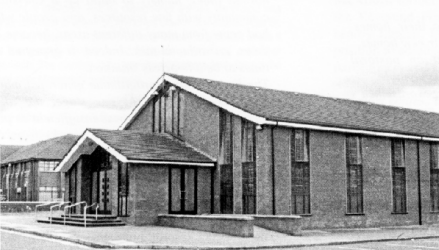
The Church of St.
Anthony, Legahory, Craigavon, was formally opened and dedicated
by Bishop Francis Gerard Brooks on Sunday 22nd. April 1979. In
1979, Moyraverty Parish had almost 6,000 parishioners, and the
new church had seating for 900 people. In October 1977, Bishop
Brooks, during a mid-day Mass in the nearby parochial hall, laid
the foundation stone of the new church. The late Fr. Seamus
Moore, C.C., Newry, bequeathed �15,000 towards the cost of
erection of St. Anthony's Church.
In a plain school-type exercise Father Murray kept a
meticulous record of the many trials, difficulties, setbacks and
obstacles he encountered as he strove to establish a meaningful Catholic
presence in the midst of an array of building-sites and conflicting
interests. Not only that, but the Troubles were building up to generate
great social unrest and instability throughout Northern Ireland in which
the new city of Craigavon was one of the most vulnerable areas.
Extra-strong Faith, nerves of steel, a supportive nucleus of population,
a parish-hall which could serve as a temporary church, a temporary
school, a community gathering-place and a visible landmark were
required. Father Christopher Murray, through Providence, had been
endowed with the first-mentioned gifts and with the support of a growing
population, the new St. Anthony's Parish Hall, Legahory, was formally
opened in August 1972 at a cost of �70,000. One month later, on Monday I
I th. September 1972, Lismore new Junior High School (first phase),
catering for pupils aged I I to 14 years, received its first pupils. in
the same week, Father Gerald Powell, recently ordained, was appointed as
the second curate to Moyraverty where he joined Fr. Murray and Fr. Pat
McAnuff. Father McAnuff has provided a most interesting account of his
work in Moyraverty as Curate, 1971-1975, and as Parish Priest,
1980-1986. Firstly, Fr. Powell's reflections:
When appointed to the new city of Craigavon,
in September 1972, I discreetly asked Fr. Christy Murray, P.P. where
Moyraverty was; he replied, "Somewhere between Lurgan and Portadown;
there are plenty of green fields and roundabouts". My first Mass was
in St. John's. Church, Lylo, followed by another Mass on the stage
of St. Anthony's Hall.
My years in Rome had not prepared me for this
challenge. People were arriving in the parish from Belfast, Lurgan,
Portadown, Strabane and Derry, either looking for employment or
because they had been intimidated from their previous homes.
Many hours were spent visiting their homes,
welcoming them and blessing their new homes. Many hours also were
spent on pastoral planning long before it became fashionable.
Collaborative ministry were buzz words then - finance meetings,
fundraising for new schools, a hall, a church; the formation of
structures, - new arrivals and old survivals to promote the
wellbeing of all the parishioners.
The priests were paid a frugal salary for long
hours of vvork and service in chaplaincy attendance at Craigavon
Area Hospital, Lismore Comprehensive School and the two primary
schools, St. Anthony's and St. Brendan's.
Masses were well attended. There were four
hours of Confessions every Saturday. There was an early 6.45 a.m.
Mass on Sundays, in the hospital, and a 6.00 p.m. Mass in Anthony's
Hall, and others in-between. it was a very active parish. Like all
the residents in the Brownlow sector, the priests lived in council
house accommodation.
At the formation of the new parish of Moyraverty,
Saint John's Church, Lylo, and Saint Joseph's Church, Edenderry near
Portadown, were transferred from Seagoe to Moyraverty. On Saturday 22nd.
July 1972, a bomb was placed in Saint Joseph's, Edenderry, and the
explosion virtually destroyed the building. The site of the church which
served a small rural community was eventually levelled and sold. Six
months later, on 5th. January 1973, a hand-grenade was thrown into the
home of Father Pat McAnuff at 48, Killycomaine Road, Portadown, where he
had been dwelling to serve the parishioners at Edenderry. Fr. McAnuff
was not injured, but his housekeeper sustained fairly serious injuries.
Later that year, the priest obtained a new parochial house at 211.
Drumglass, well within the Brownlow sector and quite close to St.
Anthony's parish hall and schools, the foci of the new parish. Father
McAnuff recalled early days in Moyraverty:
To supplement the increasing requirement for a
church in Brownlow, Father Murray acquired an ex-army Nissan Hut
which would serve as a chapel and a hall in Moylinn, beside his
rented house. St. Anthony's P.S. had been opened, and with an
ever-extending building programme and an ever-increasing number of
mobile classrooms, this gave rise to an ever-increasing number of
problems for staff and pupils whose response to the challenge was
simply extraordinary.
What would have been a difficult challenge in
normal times, namely to build up a Christian community with few
resources, and people who had come from many different areas, became
at times, an arduous task. Indeed, it appeared at times to he a
hopeless situation.
The huge building programme generated many
financial difficulties. At one stage, the total income from all
sources was insufficient to pay the interest owed to the bank.
The other parishes in the diocese came to our
aid, and following an appeal made within the parishes on different
Sundays, we got a great response.
The diocesan records highlight a red-letter day in 1977
for the parishioners and priests of Moyraverty parish. For Sunday 23rd.
October 1977, the records state:
Most Reverend Dr. F.G. Brooks was the
principal celebrant of the mid-day Mass in the Parochial Hall,
Moyraverty, today. The other concelebrants were the priests of the
parish.
During the Mass, His Lordship laid the
foundation stone of the new Church of St. Anthony which is adjacent
to the hall.
The church-site is part of the 1.75 acres plot
allocated to the parish for a church, a parochial hall, a parochial
house and a car-park. The church is being built by Laneir Ltd.,
Dublin, at a cost of �140,000. The late Fr. Seamus Moore, C.C.
Newry, bequeathed half the residue of his estate amounting to
�15,000 towards the cost of the church.
In the following month, November 1977, Fr.
Gerald Powell and Fr. Seamus Reid, who had been working as curates
in Moyraverty were transferred to Lurgan and Ballela respectively,
and were replaced by Fr. Jim Kerr and Fr: Oliver Mooney. Father Pat
McAnuff had gone to Cabra but other priests had come to Moyraverty
as the needs and population grew greater.

St. Martin's Chapel,
the first church of the fledgling parish of Moyraverty.
Reminiscent of churches built by missionaries abroad, the chapel
was initially located near to where St. Anthony's Church now
stands. After St. Anthony's was opened, St. Martin's was
re-located to Ardowen where it served the growing number of
parishioners in Drumbeg and other developments. The memory of
the little chapel remains firmly fixed in the hearts of early
Moyraverty parishioners.
Some twelve years after his courageous appointment as
Priest-in-charge of the new fledgling Parish of Moyraverty, Canon
Christopher Murray realised one of his great aims for his parishioners
when the splendid new Saint Anthony's Church was formally opened and
blessed. The diocesan records read:
Sunday 22nd. April 1979: The new Church of St.
Anthony, Legahory, Brownlow, Craigavon, was formally opened and
dedicated by His Lordship, Dr. F.G. Brooks, Bishop of Dromore, this
afternoon. Saint Anthony's is the first new permanent Catholic
church in the Brownlow sector of Craigavon. The Bishop was the
principal celebrant of the Mass. The concelebrants were: Right Rev.
Monsignor Haughey, P.P. V.G., Very Reverend Canon C. Murray, P.P.
Moyraverty, Reverend Michael Conway, Glasgow, and the following
priests who are presently serving in the parish or who have served;
Rev. G. Powell, Rev. G. Conway, Rev. Jim Kerr, Rev .Frank Kearney,
Rev. Oliver Mooney, Reverend Pat McAnuff, Rev. Seamus Reid, and the
Rev. Gerald Greene. St. Anthony's Parish has now about 6,000
parishioners, and the new church will seat 900 people.
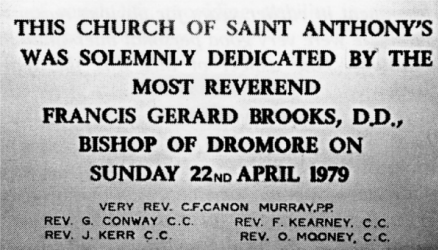
Commemorative
tablet within the entrance of St. Anthony's Church,
Moyraverty. In 1979, the team of priests in the parish
comprised, Canon Christopher Murray, Fr. Gerard Conway, Fr.
Francis Kearney, Fr. Jim Kerr and Fr. Oliver Mooney.
In January 1980, Right Reverend Dean James Haughey,
R.P. V.G. Shankill, retired, and Canon Christopher Murray was appointed
as Parish Priest, Shankill. Lurgan. In the following July, he was raised
to the dignity of a Prelate of Honour, and made Vicar General of the
Dromore Diocese. The new Moyraverty Parish Priest was the Very Reverend
Pat McAnuff, former C.C.Moyraverty. He was joined by the Reverend
Francis Molloy who was serving in nearby Lurgan. Fr. Pat McAnuff was in
a splendid position to adjudge the progress and well-being of the
parishioners and their parish. He reflected:
I must confess that that I was very pleased when Bishop Brooks
asked me, now fully refreshed, to return as Parish Priest of
Moyraverty. I noticed first and very quickly that here was now a
very vibrant parish, neighbours who knew each other, a beautiful new
St. Anthony's Church, a parish-hall offering a variety of pastimes
from bowling to badminton to Irish dancing and many very enjoyable
social gatherings. There were now five priests, living in different
parts of a very large parish. I noticed too that residents who, at
the beginning, liked to return to their former parishes,
particularly Portadown and Lurgan, to worship, to get married, and
to have their children baptised, were now readily accepting St.
Anthony's as their parish church. Different societies had grown up,
and the Sisters of Mercy, who had come from Lurgan at the very
beginning and had given unique service in every way, were involved
in the various societies, especially the St. Vincent de Paul Society
and Baptism Preparation Classes. The G.A.A. Club, aptly named Eire
0g, catered for the younger people and I'm sure that the young club
was proud to be represented in the victorious All-Ireland squad in
2002.
Ecumenical activity would not have been
prominent in earlier years for obvious reasons but there were very
good personal inter-Church relations. One aspect of this was the
real friendships and frequent meetings between the Chaplains of
Craigavon Hospital. The Reverend Jack Shearer (later Dean of St.
Anne's Cathedral, Belfast, the `Black Santa') worked tirelessly to
improve community relations locally, when that was not easy for him.
With him, I was cofounder of the local Samaritans, and I was very
proud to return with him for the Silver Jubilee of the Society a
short time before he died. Recently (2002), 1 had a very pleasant
return visit to Moyraverty when Father Michael Hackett, the present
Parish Priest, entertained me in the beautiful new spacious
Parochial House, a welcome addition to the new complex of Church,
church-hall, primary school, a complex which is a credit to the
faithful and generous parishioners, to the Sisters of Mercy, and to
the many devoted priests, past and present, who have every reason to
be proud of their contribution to the Parish of Moyraverty.
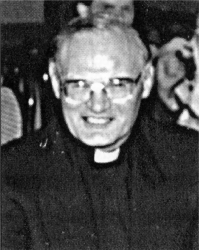
Reverend
Michael Hackett, Tyrone-born Parish Priest of Moyraverty,
was appointed to the parish on August 29th. 1993. Father
Hackett, a native of Augher, was ordained to the
priesthood in Maynooth College by Most Reverend Dr. J.C.
McQuaid, Archbishop of Dublin, on Sunday 18th. June
1967.
An impressive testimony to the cross-community
initiatives undertaken by priests and people of Moyraverty Parish in the
1970s and '80s when denominational relationships appeared to be at an
all-time low, took place at the end of Church Unity Week, 1981. The
record states:
Sunday 25th. January 1981: About one thousand
people assembled at the Unity Service in Craigavon to mark the week
of prayer for Christian Unity. An inter-denominational Act of
Worship was held in St. Anthony's Church, Craigavon. People present
included ministers and priests from the neighbouring Churches and
some of these with Lay Representatives assisted in the Service.
Salvation Army members were also present. Reverend David Gilettan,
Anglican Minister at the Christian Renewal Centre, Rostrevor, gave
the address.
A considerable number of younger priests gained
valuable pastoral experience in Moyraverty Parish within which was the
Craigavon Area Hospital, almost a parish within a parish. In the early
1980s, priests serving in Moyraverty included Fr. Oliver Mooney, Fr.
Patrick Murray, Fr. Jim Kerr, Fr. Joseph McConville, Fr. Frank Kearney,
Fr. Brian Brown, Fr. Gregory McGivern and Fr. John Carr. In February
1986, Canon Pat McAnuff, RP. was appointed Parish Priest of Drumgath
(Rathfriland and district). The new Parish Priest of Moyraverty was the
Reverend T.J. McGuinness who had served the very busy towns of Lurgan
and Newry with great energy and compassion as those towns bore the brunt
of major social and political unrest. Fr. McGuinness continued the
sterling work of his predecessors in the many spheres of pastoral work
among the disadvantaged and in Craigavon Area Hospital. The relative
peace and smooth running of the parish was shattered on Thursday 12th.
December 1991 when a huge bomb was detonated in the Moyraverty
church-school-hall complex which had the local R.U.C. Station as a
neighbour.
A condensed account of the effects of the explosion
read:
Thursday 12th. December 1991: St. Anthony's
School, Craigavon, was completely demolished, and St. Anthony's
Church and Parochial Hall, together with very many homes, were very
badly damaged by a 2,000lbs, bomb left in a truck outside the R. U.C.
Station in Craigavon.
Father Michael Farrell, C.C. Moyraverty, was
conducting a Service of Peace when the bomb exploded bringing some
of the timber ceiling down, and shattering many of the windows of
the church. No serious injuries were suffered.
Bishop Brooks described the bombing as a
"totally reckless act without regard for the consequences either in
respect of persons or property."
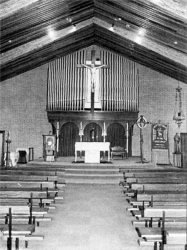
The original
Sanctuary arrangement in St. Anthony's Church. The organ has
since been relocated and a plain painted background substituted.
The large elevated crucifix remains in situ.
Seven months later, on July 5th. 1992, Bishop Brooks
concelebrated a special Mass, together with the priests of the parish,
at the re-opening of St. Anthony's Church. He praised the resilience of
the community and the priests and commended all the hard work undertaken
to restore the church. In September 1992, Fr. Francis Molloy left
Moyraverty to become Parish Priest of St. Paul's, Shankill, now a
separate entity, the large Shankill Parish having been divided in two.
Fr. Richard O'Connell who had served in both parts of Shankill Parish
was transferred to Moyraverty to replace Fr. Molloy.
In a major round of clerical changes, Father Michael
Hackett, C.C. Lurgan, was appointed Parish Priest of Moyraverty, on
August 29th. 1993. Fr. Hackett's pastorate in Moyraverty was
distinguished by a series of enlightened initiatives in the realms of
worship and prayer, parish community expansion, building and
fund-raising. The number of private housing developments within and
around the Brownlow sector has increased dramatically in the last twelve
years. Within the ambience of relative peace which has come to the
region as a whole, a settledness, previously unknown. can be detected
throughout the new parish. There are families to turn
to for the various specialisms required to sustain parish life. The
growth of population has been more than matched in Church-related social
activities where the two primary schools and Lismore Comprehensive play
leading roles.
Throughout all the changes imposed on the district
which was set aside to accommodate the new city of Craigavon, one small
population which had St. John's Church, Lylo, as its focus, remained
unchanged. A nucleus of families with deep roots in the area and which
were greatly disturbed in the troubles of 1975, augmented by families
who had given their allegiance to the bombed St. Joseph's Church,
Edenderry, remained an anchor congregation for the modest St. John's
Church, Lylo. For these families, St. John's represented the visible
aspects of Faith and community life, and they continued to be an
integral part of parish life, providing stability in an era of change
and uncertainty.
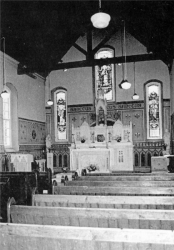
The beautiful Sanctuary and
interior of St. John's Church, Lylo
The provision of cemeteries for the people of
Craigavon was not addressed by the planners. Therefore, for a
considerable time after the many housing developments had been occupied,
Catholic funerals for the most part returned to the places of origin of
the deceased, often far distant, or were brought to either St.
Patrick's, Derrymacash or St. Colman's, Lurgan. To reduce this known
inconvenience, a body of Lylo parishioners, with the approval of the
parish priest, decided to enlarge the little cemetery attached to St.
John's Church and, at the same time, refurbish the church interior, the
centrepiece of which is a very beautiful white marble altar, the gift of
Archdeacon Edward MacCartan, P.P. Seagoe, 1889-1920.
Today, the extended cemetery, laid out in a series of
narrow green lawns and surrounded by an array of shrubs and small trees,
is an oasis of peace, set well back from a quiet country road, a rural
cameo not always associated with the bustle of Craigavon. The
refurbishment of the interior of St. John's Church, similar to the
extending of the cemetery, was undertaken completely by voluntary
workers. The gift of a vivid red carpet for the sanctuary sets off the
beauty of the magnificent white marble altar, and gold and brass altar
fittings. Irish Catholic rural churches, mainly of mid-19th. century
origin, have come to represent the emergence of the Church from
centuries of repression. St. John's, Lylo, and the congregations which
gather within, represent the continuity of Faith, worship and people in
an era and district of enormous change.
The decrease in the number of priests in the Dromore
Diocese has affected greatly the Parish of Moyraverty. Today, three
priests serve the large parish and care for the patients and staff of
Craigavon Hospital. The parish pries is assisted by Fr. Torn McAteer,
who devotes much time and devotion on a daily basis to the hospital, and
by Fr. Heery, who has returned from missionary work abroad.
Following Fr. Hackett's appointment as Parish Priest
of Kilbroney, Fr. Martin McAlinden was appointed Parish Priest of
Moyraverty in August, 2004. Aged 39 years, Fr. McAlinden is the youngest
parish priest in the Dromore Diocese for many, many years.
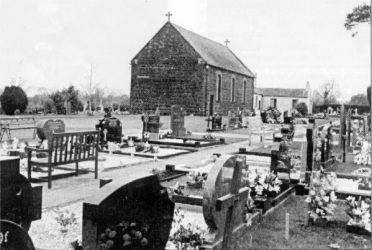
St. John's Church,
Lylo, formerly one of four churches in Seagoe Parish, is now an
integral part of Moyraverty Parish, serving that part of the new
parish which lies towards Tullylish and Portadown. This district
is on the periphery of Craigavon, comprising farmland as well as
impressive new housing developments. A major extension to the
cemetery adjacent to the church was undertaken by local
parishioners on a voluntary basis. The same families undertook
the work of refurbishment in the now beautiful church interior,
resplendent with red carpet contrasting with the magnificent
white marble altar.
 |